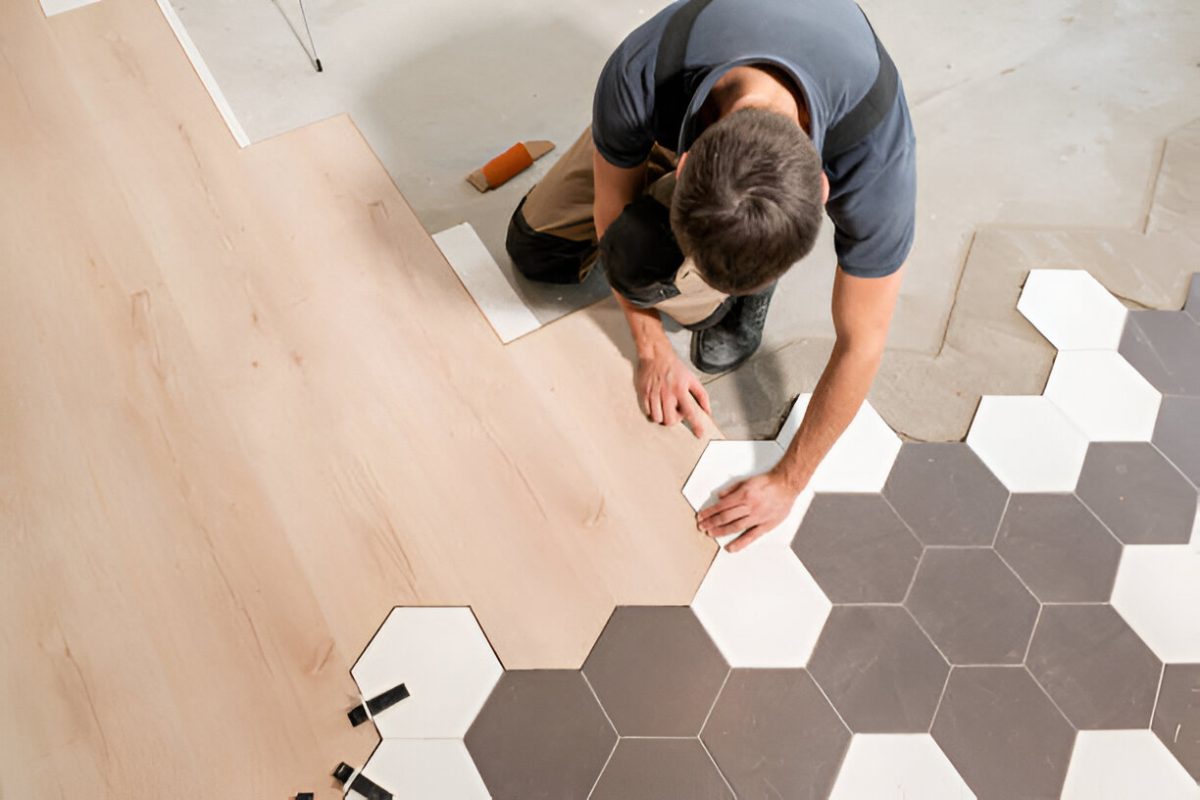
Flooring Works.
Flooring is a fundamental aspect of any building or interior space, offering functionality, durability, and aesthetic appeal. From residential homes to commercial establishments, the choice of flooring material can significantly impact the ambiance, maintenance requirements, and overall cost-effectiveness of a space. This comprehensive guide explores various types of flooring, installation methods, maintenance considerations, and the benefits they bring to different environments.
1. Introduction to Flooring Works
Flooring works encompass the installation, maintenance, and renovation of floor surfaces within buildings. Beyond aesthetics, flooring plays a crucial role in providing a stable, safe, and comfortable foundation for activities ranging from daily living to heavy commercial use. Different types of flooring materials offer unique characteristics, such as durability, ease of maintenance, acoustic properties, and resistance to moisture or wear.
Understanding the options available and their respective benefits is essential for choosing the right flooring solution based on specific needs and preferences.
2. Types of Flooring Materials
Flooring materials vary widely in terms of composition, appearance, durability, and maintenance requirements. The choice of flooring material depends on factors such as the intended use of the space, budget considerations, aesthetic preferences, and environmental impact. Here are some of the most common types of flooring materials:
2.1. Hardwood Flooring
Hardwood flooring is made from solid wood planks or engineered wood layers. It offers a classic, elegant look and is known for its durability and longevity. Hardwood floors can be refinished multiple times, making them a sustainable choice for residential and commercial spaces.
-
Advantages:
- Timeless aesthetic appeal.
- Durable and long-lasting.
- Adds value to the property.
- Can be refinished to restore appearance.
-
Applications:
- Living rooms.
- Dining areas.
- High-end retail spaces.
2.2. Laminate Flooring
Laminate flooring consists of a synthetic layered product that simulates wood or stone with a photographic applique layer under a clear protective layer. It offers affordability, durability, and easy maintenance, making it a popular choice for residential and commercial applications.
-
Advantages:
- Cost-effective alternative to hardwood.
- Scratch and stain-resistant.
- Easy to install and maintain.
- Available in a wide range of designs and colors.
-
Applications:
- Homes.
- Offices.
- Retail stores.
2.3. Vinyl Flooring
Vinyl flooring is a synthetic flooring material available in sheets, tiles, or planks. It is resilient, water-resistant, and easy to clean, making it suitable for areas prone to moisture or heavy foot traffic. Vinyl flooring can mimic the look of wood, tile, or stone.
-
Advantages:
- Water-resistant and durable.
- Comfortable underfoot.
- Low maintenance.
- Affordable and versatile.
-
Applications:
- Kitchens.
- Bathrooms.
- Healthcare facilities.
2.4. Tile Flooring (Ceramic, Porcelain)
Tile flooring includes ceramic and porcelain tiles, which are made from clay and fired at high temperatures. They are available in various sizes, colors, and textures, offering versatility and durability. Ceramic tiles are suitable for both indoor and outdoor use, while porcelain tiles are known for their strength and water resistance.
-
Advantages:
- Resistant to moisture and stains.
- Durable and long-lasting.
- Easy to clean and maintain.
- Wide range of design options.
-
Applications:
- Bathrooms.
- Entryways.
- Commercial spaces.
2.5. Carpet Flooring
Carpet flooring consists of fibers attached to a backing material and is available in various styles, textures, and colors. It provides warmth, comfort, and sound insulation, making it ideal for residential bedrooms, living rooms, and hospitality settings.
-
Advantages:
- Soft and comfortable underfoot.
- Provides insulation and noise reduction.
- Wide range of colors and patterns.
- Affordable and easy to replace.
-
Applications:
- Bedrooms.
- Hotel rooms.
- Offices (with low to moderate foot traffic).
2.6. Natural Stone Flooring
Natural stone flooring includes materials such as marble, granite, limestone, and slate, which are quarried from the earth and cut into tiles or slabs. These materials offer unique patterns, colors, and textures, adding a luxurious and durable flooring option to residential and high-end commercial spaces.
-
Advantages:
- Unique natural beauty.
- Extremely durable and long-lasting.
- Adds value to the property.
- Low maintenance (with proper sealing).
-
Applications:
- Foyers.
- Luxury residences.
- High-traffic commercial areas.
2.7. Concrete Flooring
Concrete flooring is a versatile option that can be polished, stained, or stamped to create various designs and finishes. It is durable, low-maintenance, and suitable for both indoor and outdoor applications. Concrete floors are commonly used in modern industrial-style homes and commercial spaces.
-
Advantages:
- Durable and long-lasting.
- Easy to clean and maintain.
- Can be customized with stains and finishes.
- Suitable for radiant heating systems.
-
Applications:
- Basements.
- Warehouses.
- Retail showrooms.
3. Installation Methods for Flooring
The installation method for flooring varies depending on the type of material chosen. Proper installation is crucial for ensuring durability, aesthetics, and functionality. Here are general steps involved in the installation process for different flooring types:
3.1. Hardwood and Laminate Flooring Installation
- Subfloor Preparation: Ensure the subfloor is clean, dry, and level. Install a moisture barrier if necessary.
- Acclimatization: Allow hardwood or laminate planks to acclimate to the room’s temperature and humidity.
- Installation: Start laying planks from one corner, staggering joints for stability. Use nails, staples, or adhesive as per manufacturer’s instructions.
- Finishing: Install baseboards or quarter-rounds to cover expansion gaps around the perimeter.
3.2. Vinyl and Tile Flooring Installation
- Subfloor Preparation: Ensure the subfloor is clean, dry, and smooth. Repair any cracks or imperfections.
- Layout Planning: Plan the layout to minimize cuts and ensure symmetry.
- Adhesive Application: Use appropriate adhesive for vinyl or tile installation. Spread adhesive evenly and allow it to set to the tacky stage.
- Tile Placement: Lay tiles or sheets in the desired pattern, pressing firmly into place. Use spacers for consistent grout lines in tile installations.
- Grouting (for Tiles): Apply grout between tiles, cleaning excess grout with a sponge and sealing joints once dry.
3.3. Carpet Flooring Installation
- Subfloor Preparation: Ensure the subfloor is clean, dry, and free of debris. Install a carpet pad for cushioning and insulation.
- Carpet Layout: Roll out carpet sections according to room dimensions, allowing extra material for trimming.
- Stretching and Tacking: Use a power stretcher to stretch carpet across the room, securing edges with tack strips along walls.
- Trimming and Seaming: Trim excess carpet with a utility knife, ensuring seams are tightly joined and hidden.
- Finishing: Install transition strips between carpet and other flooring materials. Vacuum and groom carpet fibers for a finished look.
3.4. Natural Stone and Concrete Flooring Installation
- Subfloor Preparation: Ensure the subfloor is structurally sound and properly prepared for the specific material (e.g., sealed for natural stone).
- Layout and Pattern Planning: Plan the layout to maximize natural stone patterns or concrete finishes.
- Mixing and Pouring (for Concrete): Mix concrete according to manufacturer’s instructions and pour into prepared forms or slabs.
- Sealing and Curing: Seal natural stone tiles or concrete surfaces to protect against stains and enhance durability.
- Polishing or Staining (for Concrete): Polish concrete floors to achieve desired sheen or stain for color variation.
4. Benefits of Different Flooring Types
Choosing the right flooring type offers numerous benefits beyond aesthetics. Each material has distinct advantages that cater to specific needs and preferences. Here are some benefits associated with popular flooring types:
4.1. Hardwood Flooring Benefits
- Natural Beauty: Enhances interior aesthetics with warm, natural tones and unique grain patterns.
- Durability: Can last for decades and be refinished multiple times.
- Value: Adds value to the property and appeals to homebuyers.
- Healthier Indoor Air Quality: Doesn’t trap allergens or dust particles.
4.2. Laminate Flooring Benefits
- Affordability: Offers a cost-effective alternative to hardwood without compromising on aesthetics.
- Durability: Resists scratches, stains, and fading, making it suitable for high-traffic areas.
- Easy Maintenance: Requires minimal upkeep with regular sweeping and occasional damp mopping.
- Versatility: Available in a wide range of styles that mimic wood, tile, or stone.
4.3. Vinyl Flooring Benefits
- Water Resistance: Suitable for moisture-prone areas like kitchens, bathrooms, and basements.
- Comfort: Provides a soft underfoot feel and warmth compared to tile or stone.
- Affordability: Offers budget-friendly options with low installation costs.
- Easy Installation: Can be installed over most existing floors with adhesive or floating methods.
4.4. Tile Flooring Benefits
- Versatility: Available in endless colors, patterns, and sizes to suit any design style.
- Durability: Resistant to scratches, stains.
